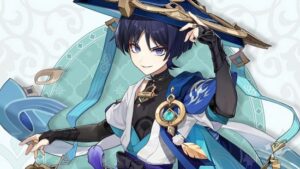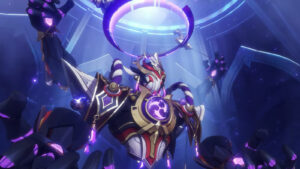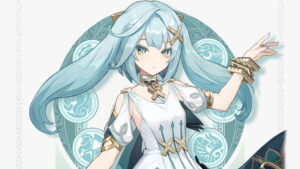SPOILERS FOR ALL GENSHIN IMPACT ARCHON QUESTS AHEAD!
Four Archon Quests deep into the overarching narrative of Genshin Impact, a couple of patterns have started to emerge. It’s pretty much a given at this point that in each new region we visit, our slowly meandering protagonist (who just wants to find her/his sibling and leave the world of Teyvat forever) will begrudgingly grow attached to a new group of characters all destined to be playable as we come together to try and prevent our common enemy, the Fatui Harbingers, from capturing the Gnosis of that region’s respective Archon. Each and every time, the situation escalates out of control and eventually requires us to put our life on the line for the people of Teyvat and their gods, and each and every time, the mission fails because at the last moment the Archons only ever halfheartedly try to stop the Fatui (to be fair, if we ever stopped to question why that is, we might realize that they’re not the bad guys in this story, but our self-righteous protagonist has a hard time comprehending that anyone they don’t get along with is a good person).
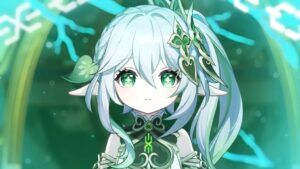
But while we fail more often than not at whatever it was we originally set out to do, letting the Fatui slip through our fingers with another Gnosis in their possession, there is something we’ve learned from all our encounters with the Archons and interactions with their subjects in three of the four regions – namely, that gods are intrinsically unfit to govern humans, and it’s only by moving forward without them and their impossible ideals that Teyvat can adapt to overcome the challenges it now faces. I don’t believe it’s merely coincidence that the Traveler’s journey began in Mondstadt, the one and only region in Teyvat whose respective Archon willingly stepped down hundreds of years prior to the events of Genshin Impact to ensure he would never become a tyrant, or that in Liyue, we helped the Geo Archon fake his own death so he could do the same for his people.
In Inazuma, the transfer of power was not peaceful – but only because the immovable Electro Archon turned out to be a semi-sentient yet emotionless puppet whose programming physically prevented her from allowing any change to occur in Inazuma. Once we got through to the real Electro Archon, Ei, who had been cooped-up for centuries meditating on the meaning of “Eternity”, we very quickly convinced her to step in and put a stop to the strife she had inadvertently caused in a misguided attempt to keep her people safe from her own intense emotions. In her second Story Quest, Ei agreed to come out of isolation entirely and rule Inazuma alongside her puppet, imparting with her what she now believes wholeheartedly; that the nation and its people can change over time and still last forever. That being said, the two of them act as a line of defense against existential threats while Inazuma’s internal affairs are now managed primarily by regular humans and youkai belonging to the Tri-Commission.
But in Sumeru, Genshin Impact bucked the trend entirely. Here, our protagonist’s intention is not to help a god abdicate, but to install a god on the closest thing Sumeru has to a throne. This seems to go against everything else the game has to say about gods and their dealings with humans, and it’s bewildering to me that more people aren’t talking about what it means – not just for Sumeru, but for the regions of Teyvat we haven’t yet visited, like Fontaine, Natlan, and Snezhnaya. First thing’s first: let’s take a closer look at what really happened in the Sumeru Archon Quest.
Sumeru, prior to our arrival, was a nation in desperate search of a god. Their current Dendro Archon, Lesser Lord Kusanali, was a mere child in god-years who had barely grown in strength and wisdom over the last five centuries, concerning her citizens and particularly the sages of the Sumeru Akademiya, who fondly remembered a time when the original Dendro Archon, Greater Lord Rukkhadevata, effortlessly kept her people safe from all manner of threats. In every corner of Sumeru, worshippers of an ancient deity named “King Deshret” had started popping up, prophesying his imminent return and eagerly looking forward to the overthrow of the weak Dendro Archon. But in the heart of the Akademiya itself, the sages were hard at work designing a god of their own – a being far stronger than the Lesser Lord Kusanali, powered by the Electro Gnosis stolen from Inazuma by the Fatui Harbinger Scaramouche, who volunteered his mechanical body to be this new god’s vessel.

Ultimately, the sages had to be stopped – if left to their own devices, they would have surrendered the care of Sumeru to a god beyond their ability to control, all while Lesser Lord Kusanali languished in a cell, incapable of protecting her people from the obvious machinations of the Fatui. A civil war between King Deshret’s worshippers and the Akademiya loyalists would have been inevitable, thousands would have died, and the nation would have tumbled into chaos, until the Akademiya itself was weakened to the point where they would have no choice but to bow to their new god’s every order. Sumeru would have become a vassal-state of Snezhnaya, and the Fatui would have gained the accumulated knowledge of the Akademiya without shedding a single drop of their own blood.
So we collaborated with Lesser Lord Kusanali to stage a coup in the Akademiya, round up the corrupt sages, and defeat Scaramouche. It was an excellent plan, and we would have pulled it off without a hitch if the Fatui Harbinger Dottore hadn’t been waiting on the sidelines the whole time, waiting for the last possible moment to swoop in and steal both the Electro Gnosis and the Dendro Gnosis, which Lesser Lord Kusanali traded for the immediate destruction of Dottore’s small army of clones and information regarding the “false sky” of Teyvat, respectively. Satisfied, the Fatui departed Sumeru, leaving Lesser Lord Kusanali to pick up the pieces and begin reassembling a deeply-divided Akademiya.
That’s where my problem arises, because that’s the situation in which we leave Sumeru, with Lesser Lord Kusanali governing the region from her position of power in the Akademiya – a prison no longer to this most indefatigable deity. It is nowhere stated, suggested, or even implied that this is to be a temporary situation, or that Lesser Lord Kusanali intends to step down at any point in the future. The Traveler believes (for reasons I think I understand, and will elaborate upon in a minute) that she will mature into a competent Dendro Archon despite her lack of experience in pretty much every scenario, and sure, she proves time and time again that she listens attentively to all her peoples’ prayers…but she’s also the first to admit that she still doesn’t fully understand human emotions, and she doesn’t know when or whether she ever will. I fail to see how even a benevolent god with good intentions can rule Sumeru the way its people deserve when the message that Genshin Impact has sent in every previous Archon Quest is that gods inevitably make mistakes and mortals always pay the consequences. It’s not like there weren’t plenty of other candidates for the job, including all the uncorrupt sages at the Akademiya (Tighnari’s master being one of the most notable).

What’s worse, the people of Sumeru have very little say in the matter. Upon defeating Scaramouche and the corrupt Akademiya sages, the Traveler and Lesser Lord Kusanali took steps to ensure no such internal threat would ever arise again by venturing deep into the pulsating heart of the Irminsul Tree, which contains all of Teyvat’s accumulated data from its past, present, and future. There, we encountered the faint remnants of Greater Lord Rukkhadevata, Sumeru’s first Dendro Archon, who had been waiting patiently for us to come along and help her erase herself from Irminsul completely. The Traveler, being an outsider to the world of Teyvat, is soon the only person who remembers Greater Lord Rukkhadevata, while the rest of Sumeru is deluded by Irminsul into thinking that Lesser Lord Kusanali was always the Dendro Archon, and that the sages were guilty of committing treason against their god.
In essence, the Traveler has eradicated every challenge to Lesser Lord Kusanali’s reign not because she’s the rightful leader of Sumeru (that claim could potentially be disputed by King Deshret, if ever he returned, but we trusted Lesser Lord Kusanali and the Akademiya sages without hesitation when they told us he was dead), nor because she proved she was the most qualified person for the role, nor even because the people of Sumeru told us they wanted her (but we “corrected” their memories, so that’s no longer an issue)…no, everything we did for her, we did because our protagonist decided for us that she was our best friend after first meeting her. And while the Traveler is certainly capable of making mistakes, this decision of theirs is not framed as one within the story, and the fandom certainly doesn’t seem to see it as one. People assume Lesser Lord Kusanali will be a good Dendro Archon because they like her character.
And that’s fine, by the way. But it’s been bothering me for weeks now that the Sumeru Archon Quest seems to set a precedent for our protagonist going around forcibly suppressing the memories of the people without their knowledge (much less their consent), rather than actually addressing the root cause for their discontent and working to change the unsustainable status quo in each region, as we’ve done in the past. In particular, I’m thinking of the Eremites, King Deshret’s loyal worshippers, and how the persecution they endured for hundreds of years (all of it perpetuated by the Akademiya, mind you, and in the Dendro Archon’s name) is swept under the rug so that they will accept Lesser Lord Kusanali as their god without argument: actually helping them is far from a top priority for the Traveler, and that responsibility is shifted onto the character of Cyno by the end of the Archon Quest.

In the most recent Archon Quest: Interlude, Inversion Of Genesis, the Irminsul Tree is tampered with yet again, this time with the effect of erasing all memory of Scaramouche. Every mention of that name, even voiced lines of dialogue, have been removed from the game entirely. The lore surrounding Irminsul is all very interesting, don’t get me wrong, but the act of altering Irminsul is already a lazy plot-device that I want to see less of going forward (the easiest solution to this problem was already foreshadowed in the Winter Night’s Lazzo trailer).
But I’m getting way off-topic. Back to Lesser Lord Kusanali, I do have one theory (that, believe it or not, came to me in a dream) for why we helped her take control of Sumeru without any caveats – a theory which I believe could also provide clues about the three Archons we have yet to meet, and their eventual fates. Bear with me here. The seven Elements personified by Archons in Genshin Impact are Anemo (air), Geo (stone), Electro (electricity), Dendro (plant-matter), Hydro (water), Pyro (fire), and Cryo (ice). You need only skim through this list to recognize that the outlier is and has always been Dendro, Lesser Lord Kusanali’s Element. Where the other Elements are inanimate and incapable of changing without external pressure, Dendro is alive. Crucially for my theory, Dendro is capable of growing, of adapting to different conditions on its own, of evolving and changing.
See where I’m going with this? It makes a great deal of sense to me that the Traveler, as the only person in Teyvat capable of wielding all seven Elements, would know that growth and adaptation are fundamental aspects of the Dendro Element (not only in real-life, but in Genshin Impact‘s gameplay as well), and would therefore know that Lesser Lord Kusanali will adapt to become the Archon her people need because it is her Element’s natural inclination to do so. I can’t actually confirm this is the case, but looking back at the free-spirited Anemo Archon, the old and stolid Geo Archon, and the shockingly violent Electro Archon, it wouldn’t be the first time an Archon’s Element has dictated their actions and personality on some level. And I doubt it will be the last.
Very soon, our travels across Teyvat will take us to Fontaine, a land presided over by the Hydro Archon, Focalors. We know from Lesser Lord Kusanali’s description of her that, like any body of water, she can be unpredictable and temperamental at times; but it may be because she’s especially susceptible to the gravitational pull of a celestial body hovering directly above Fontaine (that would be Celestia, a floating city inhabited by the suspiciously silent gods who originally put Focalors and the other Archons in power). My theory is that the raging tides within Focalors will only be calmed when Celestia is finally unmoored, whether by us, by the Fatui, or by a maddened Focalors herself. Beyond that, we know nothing for certain, but the Pyro Archon erupting before having to be extinguished and the Cryo Archon’s cold, dead heart being thawed by some demonstration of love both sound like safe bets to me.
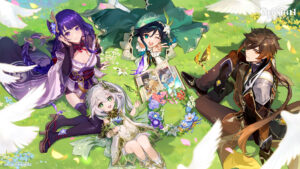
This simple theory can ultimately only justify the Traveler’s choices in-game, and perhaps help us understand their reasoning for deciding which Archons have to go, and which can stay – it doesn’t make me feel any better about the fact that even a single Archon will remain in power at the end of the day, and it doesn’t necessarily allay my fears that HoYoverse will muddle the themes of Genshin Impact‘s story. But hopefully now that I’ve gotten this off my chest, I won’t have to stay up at night scouring the internet trying to find any discussion of this topic, only to have my most convoluted search-terms produce zero results, because now this post will be out there. If anyone has similar feelings on the Sumeru Archon Quest, I encourage you to elaborate on what I’ve written here and share your own thoughts, theories, and opinions, in the comments below!




